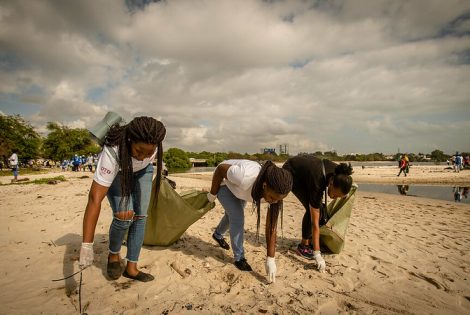
Using sport for environmental sustainability

Like any human activity, sport takes place in a physical environment. This means climate change doesn’t only affect society but also sport itself. So, it is essential to think about the relationship that plays out between sport and the environment. Furthermore, sport can contribute to protecting the environment thanks to its universal scope and the values it promotes.
Environmental education through sport
To raise awareness of environmental issues and limit the spread of diseases such as malaria, cholera, tuberculosis and dysentery, Mathare Youth Sports Association (MYSA) has launched the Environment Plus programme. This Kenyan organisation, which uses sports for socioeconomic development in the Mathare informal settlement in Nairobi, encourages its teams to clean up garbage and plant trees. Each completed clean-up activity earns them six championship points.
In 2019, I Am Water received Beyond Sport’s Sport for Climate Action Collective Impact Award for sharing ocean conservation experiences through snorkelling with thousands of students in South Africa. By facilitating physical and emotional connections to the aquatic environment, the environmental organisation aims to influence behaviour to protect the oceans.
In the same spirit, TIBU Maroc organised the final of the Think Green by ARMA national competition on World Environment Day 2021. The TIBU Fnideq Center by US Embassy team won the prize for the best social and environmental sports project. The winning project, Beach Game For Development, combines sports and protecting aquatic life in the Mediterranean. It consists of organising sports competitions, collecting and sorting waste on Rifiyine beach, and raising awareness of beach cleanliness among visitors. Used as a tool, sport can therefore contribute to making individual behaviour greener.
Environmental responsibility: The role of the sport sector
For the International Olympic Committee (IOC), “the environment fully deserves to be considered the third pillar of Olympism, after sport and culture” (IOC, 2005). The IOC intends to be climate positive in 2024. It has committed to reducing its greenhouse gas emissions by 30% by 2024 and 45% by 2030. In addition to these reductions, more than 100% of the remaining carbon emissions will be offset through the Olympic Forest, a project to plant 355,000 trees over an area of 2,120 hectares in Mali and Senegal. This will be part of the Great Green Wall, a pan-African initiative to combat the effects of desertification in the Sahel.
The Basketball Africa League (BAL) has just launched its first sustainable development project for schools in Senegal. It will provide various resources to teach students about gardening and agriculture. The project is part of the BAL Green environmental programme, which aims to develop the next generation of environmentally conscious leaders.
In addition, athletes can use their fame and media profiles to encourage political change. For example, Nawal El Moutawakel, 400m hurdle champion at the 1984 Los Angeles Olympics and a true legend in Morocco, said: “My contribution, like that of any champion, to environmental issues is to be fully committed to the principles of sustainable development, namely to adopt environmentally friendly approaches […]. My contribution is also to encourage those in charge to create new green spaces, while developing education and ecological commitment”.
Similarly, Game Earth has created a method to calculate the direct and indirect carbon footprint of professional sports players. The idea is to make them more aware of environmental issues and to reduce the impact of their activities by proposing effective compensation mechanisms. The sports world can therefore represent a powerful lever for ecological sustainability. It will be able to reach its full potential once all stakeholders have adopted comprehensive environmental measures, such as the above-mentioned initiatives.










